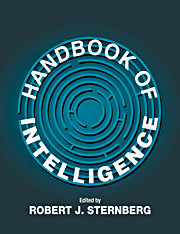Book contents
- Frontmatter
- Contents
- Preface
- Contributors
- PART I THE NATURE OF INTELLIGENCE AND ITS MEASUREMENT
- PART II DEVELOPMENT OF INTELLIGENCE
- PART III GROUP ANALYSES OF INTELLIGENCE
- PART IV BIOLOGY OF INTELLIGENCE
- PART V INTELLIGENCE AND INFORMATION PROCESSING
- PART VI KINDS OF INTELLIGENCE
- PART VII TESTING AND TEACHING INTELLIGENCE
- PART VIII INTELLIGENCE, SOCIETY, AND CULTURE
- PART IX INTELLIGENCE IN RELATION TO ALLIED CONSTRUCTS
- 26 Intelligence and Personality
- 27 Intelligence and Creativity
- 28 Intelligence and Wisdom
- Author Index
- Subject Index
27 - Intelligence and Creativity
Published online by Cambridge University Press: 05 June 2012
- Frontmatter
- Contents
- Preface
- Contributors
- PART I THE NATURE OF INTELLIGENCE AND ITS MEASUREMENT
- PART II DEVELOPMENT OF INTELLIGENCE
- PART III GROUP ANALYSES OF INTELLIGENCE
- PART IV BIOLOGY OF INTELLIGENCE
- PART V INTELLIGENCE AND INFORMATION PROCESSING
- PART VI KINDS OF INTELLIGENCE
- PART VII TESTING AND TEACHING INTELLIGENCE
- PART VIII INTELLIGENCE, SOCIETY, AND CULTURE
- PART IX INTELLIGENCE IN RELATION TO ALLIED CONSTRUCTS
- 26 Intelligence and Personality
- 27 Intelligence and Creativity
- 28 Intelligence and Wisdom
- Author Index
- Subject Index
Summary
INTELLIGENCE AND CREATIVITY
Intelligence has long been conceived of as critical in adaptation to existing environments, whereas creativity, which involves the production of an idea or product that is both novel and useful, has been viewed as critical to the modification or shaping of those environments (“Intelligence and its Measurement,” 1921; Sternberg, 1985a,b). Although there are many other definitions of both intelligence (see “Intelligence and its measurement,” 1921; Sternberg & Detterman, 1986) and creativity (see Glover, Ronning & Reynolds, 1989; Rothenberg & Hausman, 1976; Sternberg, 1988), these definitions tend to share at least some elements with these simple consensual definitions.
Definitions leave it unclear exactly what the relationship between intelligence and creativity is. A broad definition of intelligence can include shaping of the environment (Sternberg, 1985a), and a broad definition of creativity recognizes that creative ideas need to be not only novel but adaptive in some sense (Sternberg & Lubart, 1995). Just what is the relationship between intelligence and creativity?
Ochse (1990) suggested that to the extent intelligence involves selecting and shaping environments, it is creativity. To select or shape the environment to suit oneself, the imagination is required to create a vision of what the environment should be and of how this idealized environment can become a reality. On the other hand, the ability to adapt to the environment – to change oneself to suit the environment – typically involves little or possibly no creativity and may even require one to suppress creativity.
- Type
- Chapter
- Information
- Handbook of Intelligence , pp. 611 - 630Publisher: Cambridge University PressPrint publication year: 2000
- 34
- Cited by

